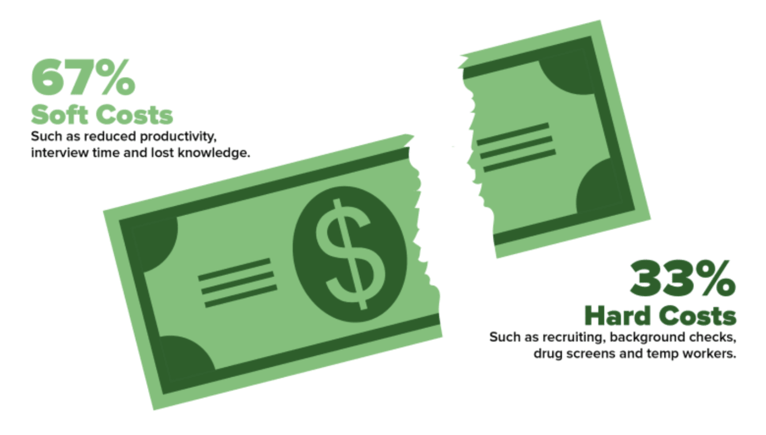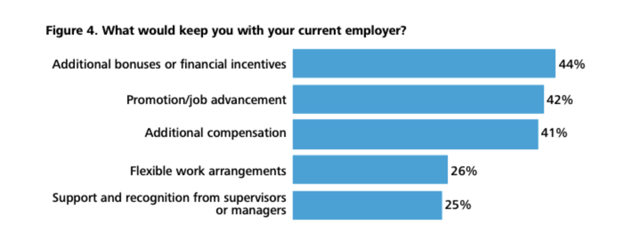For HR and Operations leaders across industries, retention is a key challenge.
With the increasing year-on-year figure of the US workforce voluntarily quitting their jobs, business leaders must find new and innovative ways to engage and retain their talent.
In this article, we’ll define what retention means and how it’s central to enterprise success, and the strategies leaders can deploy to reduce unnecessary churn.
What does retention mean in HR?
In an HR context, retention is a shorthand for ‘employee retention’ which refers to an organization’s ability to retain its existing workforce by promoting a positive working environment where employees are happy, productive, and engaged.
Retention has a direct impact on business performance as fewer employees are leaving the organization for other opportunities. In fact, 87%of HR leaders have retention as the main priority on their corporate agenda.
What is the importance of employee retention?
Employee retention should be top of mind for all HR and Operations Managers.
When an employee churns, employers are left to absorb several costs - the cost of hiring, onboarding and training a new employee (who will be less productive), to name a few.
This combined cost of turnover translates to an annual bottom line hit of $1 trillion for American companies. Beyond the financial repercussions, high voluntary turnover breaks down team morale - interpersonal relationships are a fundamental aspect to overall job satisfaction.
4.25 million Americans reportedly quit their jobs in January 2022, while a Future Forum survey shows that 57% of workers are open to seeking new opportunities within the next 12 months.
Over a quarter of millennials reported that they plan to leave their employers at some point in the next year, which was the highest percentage among all generational groups. Inconveniently, they also happen to be the generation who will soon make up the majority of the global workforce.
Source: SHRM
On the other hand, securing employee loyalty long-term pays dividends. This is because employees become more valuable over time - they are an ‘appreciating asset’. In other words, the longer employees stay, the more advantageous it is to the company - culturally and financially.
What are the best practices of employee retention strategies?
The best practices for retention strategies require an employee-focused approach involving corporate decision-making that champions a work environment to ultimately retain talent and maintain productivity.
After all, retaining an employee is easier than recruiting, training, and integrating them into the culture. According to Zippia, besides the average hiring cost of one employee totaling $4,425, it takes them 12 weeks to be fully productive.
In doing so, retention strategies can act as a powerful differentiating tool that reduces employee turnover, attracts and retains talent, and fosters an engaged workforce.
5 employee retention strategies
With increasing turnover leaving companies without their top talent, how can employers establish themselves as worth staying with? Read on about the 5 employee retention strategies to retain your talent.
1. Make growth and development a priority
Providing timely and relevant continuous learning, training and upskilling opportunities is central to creating an engaged, productive and loyal workforce. When you invest in an individual’s success, they invest in you. Companies rated highly on employee training experienced 53% lower attrition.
Receiving information that empowers people to perform their jobs more successfully, or to expand on their skill-set, is engaging. By formalizing learning as a part of daily life, you ensure employee engagement never wanes.
Boredom breeds disengagement, which leads to churn. If people feel like they are gaining new, valuable knowledge daily, they won’t have a chance to feel stagnant - 94% of employees would stay longer at a company if it invested in their professional development.
Think beyond the day-to-day by understanding what individuals’ aspirations are. Once their goals - long and short-term - are established, give them incentive to stick around by helping steer them towards achieving them. Make their progress an ongoing and central discussion to performance reviews.
If people as though they have hit a ceiling and are no longer learning anything beneficial or advancing through the rungs of the organization, they will look elsewhere for opportunities that enable them to progress.
A Deloitte report found the top factors influencing employees to switch companies was lack of career progress (37%) and challenge in their jobs (27%).
2. Reward and recognize
Rewards are a way of externalizing your gratitude for employees’ hard work, and can be tangible or intangible.
Tangible rewards include financial remuneration like gift cards or bonuses, or even physical employee gifts. These types of rewards are powerful short-term motivators. They tap into peoples’ extrinsic motivation, which is when people act in response to an external reward.
The trouble with tangible rewards is that they have an expiry date - people are loyal up to the point that they receive the reward. They also don’t meaningfully distinguish your company from any other. Many employers can hand out gifts, and can probably hand out a better gift than you.
It’s intangible rewards and recognition that will really set you apart from the crowd. These include things like managerial praise, words of affirmation, recognizing employees’ accomplishments (especially publicly) and showing appreciation.

Source: Deloitte
Intangible rewards and recognition are things that are unique to each company because they’re inherently human. Being an appreciated member of a team and having a good relationship with your manager, for example, is something you can’t attach monetary value to, or easily replace.
Longer-term ways to reward and recognize employees include promotions, raises and internal hiring, where these have been earned.
This sends the message that you’re paying attention to what people are achieving, value it and are invested in helping them make their long-term goals a reality. Companies with high internal hiring experience 41% longer employee tenure.
3. Support employee wellbeing
Employee wellness is determined by many factors, but it boils down to people feeling supported, accommodated and empathized with.
The importance of empathy in the workplace can’t be overstated. Not only are 90% of employees more likely to stay with an organization empathetic to their needs, but they are willing to work longer hours. (60% would even take slightly less pay if it meant their employer was empathetic!)
ou can practice being an empathetic employer in your daily interactions by putting yourself in others’ shoes. When communicating or making a decision, take a moment to reflect. If you were in their situation, what treatment would you like and respond best to?
On a macro level, enshrine employee wellbeing by writing it into your company policy. For example, offering ample time for parental leave, annual leave, sick days and compassionate leave. To employees, these are things that eclipse the importance of work. Show them that they’re important to you too in order to boost morale and loyalty.
Similarly, make sure people are maintaining a healthy work-life balance. If you see employees online beyond working hours - tell them to sign off. Since the start of the COVID-19 pandemic, 37% of people report working longer hours, and 40% report burnout. Overworked employees burnout, which leads to decreased work quality, output and churn.
Some people also work better in different environments, and at different times. Does their role require them to be in the office (or available online) from strictly 9am-5pm? Be flexible on working arrangements and hours. By making everyone work fixed hours, and in a specific location only, you counterintuitively stifle productivity.
Companies rated highly on flexible work arrangements experienced 137% higher headcount growth.

4. Share your success through ESOPs
Is your company experiencing success? Share it with your employees! By offering stock options, you are extending employees the opportunity to capitalize on a percentage of the wealth the company generates.
After all, they are the driving force behind it. Employee Stock Ownership Programs (ESOPS) are a great way for organizations to share their success with employees. In fact, employee-owners reported higher levels of satisfaction, commitment, and motivation with a 4-5% productivity gain when ESOPs were introduced.
This makes people feel accountable for your company’s future growth and gives them a greater sense of ownership, allowing them to feel more connected to the business. Because their stake is greater, their investment in your success increases.
It also provides a long-term incentive to stay on board - the more they contribute to your success over time, the greater their stock value.
5. Empower them with a voice
When people feel heard, they are 4.6 times more likely to perform at their very best. This is because they feel like they are a respected part of an ongoing dialogue between employer and employee.
Regularly check in on employee sentiment by sending out short surveys, frequently. When surveys are lengthy and infrequent, they suffer low completion rates and employees lose faith in the power of their voice to enact meaningful change
One of fastest ways to destroy workplace morale is to ask employees their opinions about it, then ignore their answers .
Concise, frequent surveying is key. When 1000+ people complete a 20 minute survey, reading through their responses alone is time consuming enough, never mind enacting tangible change.
And when you are unable to turn feedback into action quickly, employees begin to perceive you as insincere and your feedback-seeking as a mere gesture. This gives rise to apathy, lack of trust and frustration.
What is a stay interview? It’s the opposite of an ‘exit interview’. Exit interviews are useful in their own right - people more freely speak their mind when there’s nothing to lose so their feedback is more likely to be honest and unfiltered.
But rather than finding out why someone’s chosen to leave when it’s too late to remedy the situation, stay interviews allow you to pinpoint what motivates people to stay, as well as diagnose issues (individual and widespread) early on.
Why have they remained at the company? What do they want from you to supercharge their performance? What is the preferred way to be recognized?
Stay interviews improve employers’ self-awareness. When you understand how you are perceived, you’re in a stronger position to act to sway the pendulum in your favor. You learn what individuals value as your unique selling point, and get a better hold on their expectations from you going forward. This is essential information for optimizing an employee retention strategy.
The takeaway - how to ensure employee retention
Is your company’s culture unmatched? Is your managerial support unparalleled? Do you listen and act on feedback?
Are you attentive, empathetic, and understanding? Are you committed to your workforce’s ongoing growth and development?
The secret to mastering the retention of employees is by making yourself indispensable as an employer.
Being the most attractive option to employees includes investing in growth and development, wellbeing, feedback, stock options, and recognition. Employees will repay you with something invaluable - their loyalty.
Want to see how you can use eduMe to train, inform and engage your employees, contractors, clients or freelancers, no matter where or how they work? Companies such as Uber, Deloitte and Grubhub are already using our mobile learning platform to deliver relevant training content directly to workers’ devices, providing seamless access to information and embedding learning within the flow of work.
Book a free demo with us today to see how we can help empower and retain your workforce 👇







